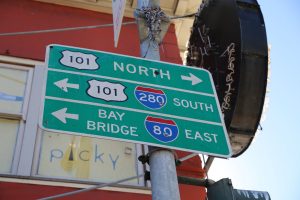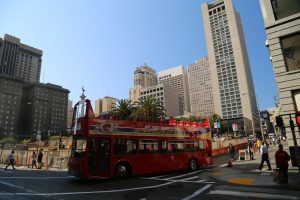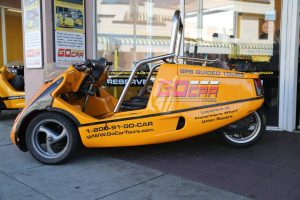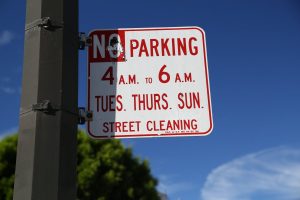
 San Francisco is NOT a car friendly city for many reasons; it is a very difficult city to drive in. In general, drivers in San Francisco tend to be aggressive and quick to honk. There are numerous hills and many are extremely steep. Space is at a premium in San Francisco – especially on the streets.
San Francisco is NOT a car friendly city for many reasons; it is a very difficult city to drive in. In general, drivers in San Francisco tend to be aggressive and quick to honk. There are numerous hills and many are extremely steep. Space is at a premium in San Francisco – especially on the streets.
Some streets do not allow parallel curb parking. They are so steep that you must park your car perpendicular to the curb. There are quite a few one way streets and the streets tend to be narrow. Also there are many specific signs and info to follow depending on which street you are on.
Take Market Street for instance. To someone from a small town trying to drive this crazy thing called a street, it would be extremely chaotic and stressful. Market Street splits numerous times along its length into two lanes divided by a concrete divider – one side for buses and carpools the other side for regular traffic – although if you are in a car, you can drive in either lane. Metal tracks run down the middle of Market Street and regularly you have buses and trains driving among vehicular traffic. In addition, parts of Market Street are very popular with pedestrians, bikers, skateboarders and other things that have wheels – there are many moving pieces to driving this street. Parts of Market Street are painted multiple colors further complicating things. Then to top it off many of the cross streets intersecting with parts of Market Street are one way streets and you cannot turn the direction you want to go. Then even worse, some of the one way streets do not allow you to turn in the direction of the traffic. You can literally spend 20 minutes trying to go around the blocks(s) in order to change your driving direction. Its crazy.
In general, based on personal experience in San Francisco from both behind the wheel and on the seat of a bike, bikers tend to feel they have the right away regardless of the situation (and we have personally witnessed situations where those on bikes start yelling at vehicles). I personally bike almost every day and if there is one thing I have learned based on years of biking – in reality, cars are bigger then bikes and bikers need to be extremely careful when riding in San Francisco. From a drivers perspective, especially from visitors to the city who don’t drive these streets every day – driving here can be a daunting experience that requires full attention because of the reasons mentioned above and because there are so many pedestrians and bikers.
Driving in San Francisco, like many other large cities has additional obstacles that you do not have in small towns. Take a street with 3 lanes, the left lane may turn into a “turn only” lane (or ‘conveniently’ will be commonly blocked by construction), the right lane most likely will be blocked by some delivery vehicle (or often construction), and if you are *lucky* the middle lane will be moving.
Some intersections have stop signs that do not function by the global norm of Red means stop and Green means go. Rather, the obvious signal lights are all flashing orange continuously on both sides of the traffic flow – and you have to know whether to stop or continue through the intersection without stopping.
How many cities have sexual traffic flow? This, was pointed out to my by one of the city’s renowned cab drivers as we were driving near Union Square. I could clearly see prostitutes standing on the sidewalks, and then my driver pointed out certain cars dodging in and out of traffic to come over to the curb sides to “meet the ladies”.
Ride sharing services (Uber, Lyft, etc) dominate San Francisco and you do not see nearly as many taxis as you used to. It is no wonder these type of services got their start here. With overnight parking rates for a car at some hotel garages rivaling or more then what you would pay for a person to stay at a hotel in another town – it might pay to park your car in a neighborhood and then take a ride sharing service to your hotel.
Parking
Parking can be horrific in San Francisco especially in the heart of the summer tourist months – namely August, mainly near tourist destinations. In certain tourist areas such as the neighborhoods and streets near Fisherman’s Wharf – its best to find parking early in the day and use a garage. Dave has actually parked a block and a half from Union Square legally (the heart of the city’s main shopping district) for FREE. No secrets given out here though!
Free parking is often available in residential neighborhoods but usually is limited to an hour or two hours at a time. Parking spots that are available are usually small and if you are not used to parking in tight spaces can be extremely challenge, especially if you are driving a larger vehicle. In addition, most streets in the city are littered with parking restriction signs and in some cases you almost need a PhD to figure out all the timing rules and regulations presented which can vary from block to block or sides of the street.
San Francisco tends be infatuated with sweeping its curbs; this further limits curb side parking on many streets – we’ve actually seen parking officers following street sweeping vehicles, quickly handing out parking tickets to keep pace with the street sweeper ahead of them.
And to further complicate matters, based on personal experience, many of the parking meters are jammed with gum or coins and cannot accept coins. With that said, most parking meters generally accept credit cards.
Public Transportation
Many residents of San Francisco do not even own a car based upon the aforementioned problems of driving in this city. There is good public transportation and MUNI is the metro system of San Francisco. Underground and above ground routes crisscross the city. BART (Bay Area Rapid Transit- Schedules, Pricing and Routes available here) is an alternative public transportation – BART runs to SFO (San Francisco’s International Airport) – you can catch BART via MUNI (MUNI Schedules, Pricing & Routes available here). Cable cars also are popular.
One nice thing about driving in San Francisco is that its a small city, barely 7 miles across from ocean to bay. As long as you know the direction you are trying to go in, its not too difficult to get lost.




Leave a Reply